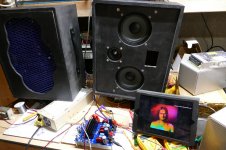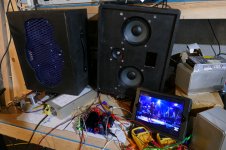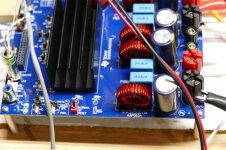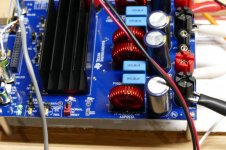@Robin
The board needs 2Vrms input. The minidsp is clipping at 0.9Vrms already. Easiest mod is to increase the gain of the boards opamps.
@DPH,
avoid BJT input opamps in this constellation, they are suspicious to EMi noise (and might get you in trouble when not used with unity gain). Better go for some CMOS input and/or Emi-hardened ones. TI offer a variety of hardened like OPA1602 or so.
YMMV.
The board needs 2Vrms input. The minidsp is clipping at 0.9Vrms already. Easiest mod is to increase the gain of the boards opamps.
@DPH,
avoid BJT input opamps in this constellation, they are suspicious to EMi noise (and might get you in trouble when not used with unity gain). Better go for some CMOS input and/or Emi-hardened ones. TI offer a variety of hardened like OPA1602 or so.
YMMV.
Last edited:
@Robin
The board needs 2Vrms input. The minidsp is clipping at 0.9Vrms already. Easiest mod is to increase the gain of the boards opamps.
i know im leaning on the brains in this board a lot, but care to advise which components i should swap to achieve this? ( i guess the 4 10kohm feedback resistors on the NE5532?) which values to use? or is there something in the documentation?
Last edited:
Robin -- the NE5532 is being used in an inverting setup, so gain = (-Rf/Rg)
You could look at lowering Rg (R7, R20, R27, R42) to 4.7 kohm. Accept that your input impedance has similarly dropped. Someone with a working brain will hopefully tell us what the new highpass/dc block frequency would be.
Otherwise raise Rf (R8, R21, R25, R41) instead. With the higher gain, you may be able to bypass the lead capacitors entirely.
Here's the documentation you should be looking at: http://www.ti.com/lit/ug/slou441/slou441.pdf (Pg. 17)
You could look at lowering Rg (R7, R20, R27, R42) to 4.7 kohm. Accept that your input impedance has similarly dropped. Someone with a working brain will hopefully tell us what the new highpass/dc block frequency would be.
Otherwise raise Rf (R8, R21, R25, R41) instead. With the higher gain, you may be able to bypass the lead capacitors entirely.
Here's the documentation you should be looking at: http://www.ti.com/lit/ug/slou441/slou441.pdf (Pg. 17)
ok so, am i right in thinking that if a 10kohm resistor is used for a 2v input and since 0.9v is 45% of 2v, you want 45% of 10kohm for the Rg value? and 4.7 is nearest common value?
also, an rc filter im adding between minidsp and amp will reduce gain by 3db, actual input voltage will be nearer 0.64v max.
assuming the above are correct i should look at an Rg value closer to 3kohm ( .64v is 32% of 2v) ?
makes vague sense in my head at least.
also, an rc filter im adding between minidsp and amp will reduce gain by 3db, actual input voltage will be nearer 0.64v max.
assuming the above are correct i should look at an Rg value closer to 3kohm ( .64v is 32% of 2v) ?
makes vague sense in my head at least.
You're definitely on the right track. I'm surprised the loss in the RF filter (doesn't add up).
Here's some handy and hopefully understandable application notes to help you along:
Gain/Compensation of Opamps
http://www.ti.com/lit/an/sloa020a/sloa020a.pdf
RFI incursion/filtration:
http://www.analog.com/media/en/training-seminars/tutorials/MT-096.pdf
Here's some handy and hopefully understandable application notes to help you along:
Gain/Compensation of Opamps
http://www.ti.com/lit/an/sloa020a/sloa020a.pdf
RFI incursion/filtration:
http://www.analog.com/media/en/training-seminars/tutorials/MT-096.pdf
Last edited:
re. the RC filter, im still at kindergarten on that subject too.
i was basing the 3db loss on the response at the end of my rc filter thread here.
http://www.diyaudio.com/forums/anal...c-filter-component-selection.html#post5225334
i was basing the 3db loss on the response at the end of my rc filter thread here.
http://www.diyaudio.com/forums/anal...c-filter-component-selection.html#post5225334
I also have a multi-ch Linkwitz system to power.
Looks like we’re gonna be best friends!
Looks like we’re gonna be best friends!
Especially when the diyAudio store has Nelson's Lxmini crossover in stock.
Especially when the diyAudio store has Nelson's Lxmini crossover in stock.
Last time I talked to him he had the LXmini xovr done, and blessed by Siegfried,
and was talking about working on a bass crossover to make an Lx Studio. But hadn’t done much. I doubt he ever does any for the LX 521.. that would be complicated! Also Nelson just really likes the mini.....
This analog crossover option probably means I’ll be building the mini first, then add the Studio option when we hope Nelson will finish the bass xovr, then take my time on the 521
I’m quite sure we’ll stock the crossover...
Last edited:
Have you checked for......
My impatience got the best of me, I just put the cover back on the supply and set it aside. I didn't want to risk series connecting two 1 kilowatt bench supplies without reading the manual, so I looked for another alternative.
Digging through my stuff yielded an Astec SMPS that was still in it's original packaging with the test sheet attached, from 2004. Where it came from, I don't know. It has two separate 42 volt 7.2 Amp outputs. A web search didn't answer my question as to whether these can be wired in parallel, so I just did it. I connected this power supply up to the EVB, connected the EVB to some speakers that I built years ago for testing big power tube amps intended for musical instrument use. The main criteria when I built these speakers was blowout resistance and cheap drivers, so they are just right for this kind of test. I found a cable that connected my iPAD to the input jacks, and plugged it in.
When I flipped the switch from reset to normal I almost dropped the iPad. Loud isn't the word. These speakers have a pair of 8 ohm 6 inch drivers in parallel for a 4 ohm load with a "bullet" tweeter crossed over with a 4 microfarad cap. There isn't a whole lot of bass, but I can say this is the first time that I have felt the thwack of a SNARE drum in my chest from these speakers.
I will get to testing this thing with lab power supplies, and an audio analyzer, but for now I'm just going to listen to it. Currently cranking some Emerson, Lake and Palmer, it's loud, but even with loud music the iPAD can't drive this thing to clipping even with 42 volts of B+.
Attachments
I must take back what I said earlier. If you search through your music library long enough, you can find music that will light the "clip" LED from an iPAD headphone jack. Several songs from Trans Siberian Orchestra will make it blink occasionally. Punching In A Dream by The Naked And Famous, will make it stay almost constantly illuminated. The amp still did not misbehave or "fault." So far the only "fault" happened when I accidentally pulled the headphone cable out of the iPAD while playing loud music)connected to the EVB input). A disconnected (open) speaker wire at full tilt did not bother it, but I turned the volume down before reconnecting.
Note that the clipping will probably not happen with a 48 or 52 volt power supply.
This is absolutely the best $81 amplifier you will ever buy, I gotta connect my guitar to this thing! Long term, however it will drive a subwoofer.
Note that the clipping will probably not happen with a 48 or 52 volt power supply.
This is absolutely the best $81 amplifier you will ever buy, I gotta connect my guitar to this thing! Long term, however it will drive a subwoofer.
Attachments
Last edited:
Thanks again. It works and will adjust from about 35 volts until the OVP shuts it down somewhere around 54 volts. I set it to 48.5 volts and tested the EVB. The voltage stays rock steady at 48.5 volts even at stupid loud volume levels.
The EVB will now take full output from the iPAD with any music without clipping. It is stupid loud, with 91 db speakers.
I will make some real measurements later. I need to find my 1:1 audio transformer to attach test equipment to the speaker lines since it runs BTL.
The EVB will now take full output from the iPAD with any music without clipping. It is stupid loud, with 91 db speakers.
I will make some real measurements later. I need to find my 1:1 audio transformer to attach test equipment to the speaker lines since it runs BTL.
I attached a rudimentary BOM and schematic markup for the PFFB implementation.
Haven't yet looked at selection of the components that do not have a location on the PCB (e.g. C_fb_in, C_fb_out, R_fb_gnd). I assume NP0 and thin film would be adequate, but it would be somewhat tricky to get these components attached. Maybe mini PCBs would help...
Haven't yet looked at selection of the components that do not have a location on the PCB (e.g. C_fb_in, C_fb_out, R_fb_gnd). I assume NP0 and thin film would be adequate, but it would be somewhat tricky to get these components attached. Maybe mini PCBs would help...
Attachments
- Home
- Amplifiers
- Class D
- TI TPA3255EVM



